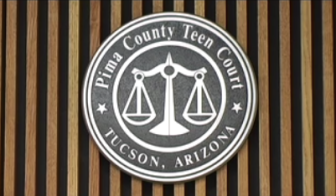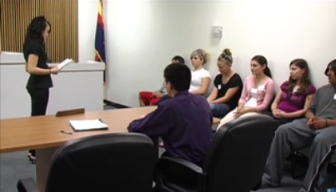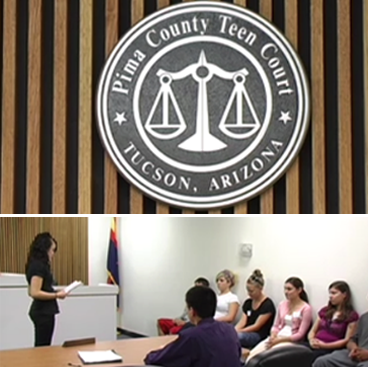
Pima County Teen Court / (http://www.pcteencourt.com)
Kate Spaulding, Coordinator of Teen Court in the Schools (TCIS) presented on the Pima County Teen Court.
Peer pressure is not necessarily a bad thing, according to Nancy Fishman, youth justice programs project director for the Center for Court Innovation. In fact, peer pressure can be very positive when applied through youth courts that are part of school discipline.
“It helps students create positive messages for other youth,” Fishman said during an OJJDP-sponsored webinar on Wednesday titled “Using Youth Courts as a School Discipline Practice.” “The goal isn’t to have teenagers pretend to be adults.”
Youth courts -- disciplinary alternatives involving students who mimic a trial jury -- aren’t merely mock performances, she said, because the punishments meted out are officially binding as school reprimands. They can be powerful tools, and allow young people to participate in and benefit from civic engagement, she said.
“Youth courts are focused on accountability,” Fishman said. “The added value [is] that it isn’t just an alternative disciplinary approach of the school.”
In 2010, she said that an estimated 1,100 youth courts were in operation across the United States, and nearly two-fifths of them were school-based programs.

Photo courtesy of Pima County Teen Court / (http://www.pcteencourt.com/)
Pima County Teen Court.
“The purpose of the youth court is to figure out what the community’s response is going to be,” she said. “The model, with its core principles, can be flexible in how it fits into a community.”
Generally, youth courts deal with lower level offenses that are almost always non-violent and involve first- or second-time offenders, Fishman said.
The intent of youth courts, Fishman said, is to provide “constructive” alternatives to exclusionary discipline practices, such as detention and suspension. As a result, students that participate in the programs -- which are usually voluntary -- learn how to change disruptive behaviors and make better individual decisions.
“It is particularly suited to working with young people who are in the process of testing limits and learning and growing, even when they make mistakes,” Fishman said.
All youth courts have different characteristics and practices, she said. But most follow a structure similar to real-life trial courts, with referrals, screenings, and intake processes followed up with hearings, sentencing and monitoring of sanctions.
However, youth courts need a commitment from the school, she said.
“It’s very difficult for a youth court to do that on its own without support from the rest of the school structure,” she added.
In some schools, youth courts have adopted “timebanking” to involve the community.
“Basically, the idea is neighbors helping neighbors,” Lorrie Hurckes, co-director of the Dane County TimeBank Youth Court in Wisconsin, explained. “People earn credits for the time spent doing things for others.”
Time spent helping others in the community -- by providing voluntary childcare, mentoring or tutoring services, for example -- can be “deposited” into a communal “timebank.” That time can then be used to procure volunteer services from other individuals in the neighborhood.
The TimeBank Youth Court began as a pilot project in 2006, Hurckes said, and initially served as an alternative for young people who had contact with the juvenile justice system. The program was so successful that by 2012 the program had expanded to every high school in the district.
Hurckes said the program is modeled after the Time Dollar Youth Court in Washington, D.C., and takes referrals directly from police officers. Often, young people are given the option of participating in the youth court in lieu of receiving a ticket, she said.
“I’ve been doing this since 2007,” Hurckes said. “And I’ve never seen anyone reject it.”
